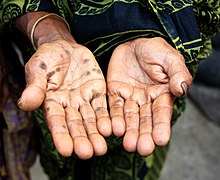Poisoning
This article may need to be rewritten to comply with Wikipedia's quality standards. (January 2022) |
This article needs additional citations for verification. (June 2019) |

Poisoning is the harmful effect which occurs when toxic substances are introduced into the body.[1] The term "poisoning" is a derivative of poison, a term describing any chemical substance that may harm or kill a living organism upon ingestion.[2] Poisoning can be brought on by swallowing, inhaling, injecting or absorbing toxins through the skin. Toxicology is the practice and study of symptoms, mechanisms, diagnoses, and treatments correlated to poisoning.[3]
Levels of Exposure
When a living organism is introduced to a poison, the symptoms that follow successful contact develop in close relation to the degree of exposure.[4]
Acute exposure
Acute toxicity/poisoning consists of a living organism being harmfully exposed to poison once or more times during a brief period, with symptoms manifesting within 14 days since administration.[5]
Chronic exposure
Methods of Poisoning
Accidental poisoning

In 2020, America's Poison Centers' NPDS (National Poison Data System) report determined that 76.9% of recorded toxin exposures were accidental, with the rest of the statistics either being deliberate or unexpected.[9] A large portion of these accidental incidents occurred due to mistakingly taking the incorrect medicine, or doubling one's dose by mistake.[9]
Industry and Warfare
Pesticide exposure
Most biocides, including
Toxication
Many substances regarded as poisons are toxic only indirectly through toxication. An example is "wood alcohol" or methanol, which is not poisonous itself but is chemically converted to toxic formaldehyde and formic acid once it's reached the liver.[16] Many drug molecules are made toxic in the liver, and the genetic variability of certain liver enzymes makes the toxicity of many compounds differ between people.
Precautionary Measures
| Poisoning | |
|---|---|
human skull in front of two bones crossing one another.[19]
GHS precautionary statements, which advise users to exercise caution or be aware of the substance's potentially dangerous features, are added to a legal toxins' labelling.[20] Toxic substances can also come with instructions on how to handle the product, what compounds to avoid mixing the product with, and how to treat a victim at risk of poisoning who has come in contact with the product.[21] Various poison control centers are also available to assist in diagnosing, managing, and preventing possible incidents of poisoning.[22] Many are accessible through phone calls or official websites. TreatmentSeeking medical attention is strongly advised if someone is thought to have been exposed to or consumed a poison, mainly from a nearby poison control centre.[23][24] It is advised to provide medical personnel with information regarding the poisoning, the patient's age, weight, and any other drugs they may be taking in addition to the symptoms of the illness. Try to determine what was ingested, the amount and how long since the person was exposed to it. If possible, have on hand the pill bottle, medication package or other suspect container.[25] The treatment will depend on the substance to which the patient is exposed. Depending on the type of poisoning, some first aid measures may help. Treatments include activated charcoal, induction of vomiting and dilution or neutralizing of the poison.[26] See also
References
External links |
